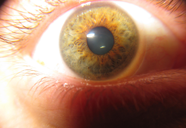
My What Big Contacts You Have
Tens of millions of Americans suffer from dry eyes. For an especially bad condition, it feels like there’s always sandpaper in the eyes. But instant relief can be found in a pair of wide-diameter contact lenses called scleral contact lenses.
A conventional rigid contact lens is about 9 mm. in diameter. It lies on the cornea, which covers the colored part of the eye. A scleral contact lens vaults over the cornea and rests on the sclera, the white part of the eye. Underneath the dome, a reservoir of saline solution bathes the eye. Scleral contact lenses typically are 15 to 22 mm. in diameter.
Scleral contacts have been available for decades, but major improvements in materials and design have sparked a resurgence in their use. “They are the hot topic in the contact lens field,” said optometrist Peter Russo, OD, director of the contact lens service of Loyola University Health System.
While dry eyes can occur at any age, they are most common in the elderly. Nearly five million Americans age 50, and older (3 million women and 1.5 million men) have dry eyes, and tens of millions have less severe symptoms, according to the National Eye Institute. Symptoms include stinging or burning; a feeling that something sandy or gritty is in the eye; pain and redness; episodes of blurred vision; heavy eyelids; eye fatigue and decreased tolerance of activities that require sustained visual attention, such as reading or working on the computer.
Dry eyes can be due to many factors, including side effects of medications; skin disease around the eyelid; pregnancy; hormone-replacement therapy; LASIK surgery; allergies; and immune system disorders such as Sjogren’s syndrome, lupus and rheumatoid arthritis.
Dr. Russo said scleral contacts, made of hard plastic, have improved dramatically in the past few years. Unlike earlier scleral contacts, the newer lenses are gas permeable, meaning they allow oxygen to permeate through the lens to provide oxygen to the surface of the eye. Each lens is custom-fit to the wearer’s eyes; a computer-assisted lathe produces an extremely precise curve on the back of the lens.
Eye drops can help, but the relief often is temporary. Drug stores sell many over-the-counter brands of lubricating drops, but there is no conclusive evidence that any one product works best for all dry eye sufferers.
*******
excerpted from ScienceDaily photo via Flikr: http://bit.ly/GTKyur
Have a thought about this article? Contact Us and let us know.